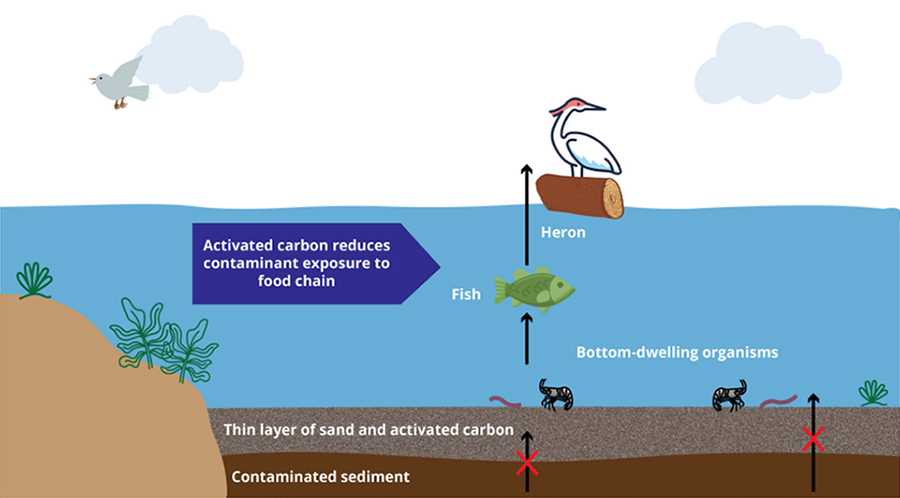March 23, 2023

By exploring how chemical contaminants move through the environment and affect aquatic food webs, Upal Ghosh, Ph.D., of the University of Maryland, Baltimore County (UMBC), aims to develop and implement technologies to help ecosystems recover from pollution.
With consistent NIEHS funding since 2007, Ghosh studies contaminants called polychlorinated biphenyls (PCBs), which can build up in organisms over time and along the food chain. Ghosh assesses pollutant bioavailability, or the amount of a contaminant available for uptake by fish and other organisms, with a particular focus on PCBs.
“During my undergraduate studies in chemical engineering, I got to visit different industrial sites and understand how we produce chemicals in bulk,” Ghosh said. “Although chemical industries provide many benefits for people — producing thousands of consumer products we use today — I was disappointed to see the problems that occur when chemicals like PCBs are mismanaged and enter the environment.”
His goal is to use nature-based strategies to clean up contaminants and reduce exposures in aquatic organisms and humans alike.
PCBs Pose a Public Health Issue
PCBs are a group of chemicals formerly used in many industrial and consumer products, such as electrical equipment, insulation, paint, and plastics. Although the federal government banned PCB production in 1979, the compounds persist in soils, sediments, and water bodies due to their stable chemical structure.
Exposure to PCBs has been associated with a wide variety of health effects, including liver problems, poor birth outcomes, hormone disruption, and cancer. In general, people are exposed to PCBs by eating contaminated fish, meat, or dairy products.
“If we can limit the amount of PCBs bioavailable to fish, we can also help protect human health,” Ghosh explained.
To better understand PCB accumulation in organisms, Ghosh’s team has been studying the Anacostia River in Washington, D.C., which faces ongoing PCB contamination. The river’s long history of urbanization and industrialization has resulted in pollution, poor water quality, and contaminated sediments in the riverbed.
The team deployed passive samplers and freshwater mussels into the Anacostia River as dual methods to identify PCB sources. Mussels are sedentary, long-lived filter feeders that have been shown to accumulate contaminants without metabolizing them. They then developed models to accurately predict PCB accumulation in mussels and different fish species in the river.
According to Ghosh, this research demonstrated that controlling ongoing PCB inputs from one heavily impacted tributary was critical for the reduction of PCB levels in fish.
“At many contaminated sites, we found that PCB hotspots were located near disadvantaged communities,” Ghosh said.
Carbon Pellets Remove Pollutants

Generally, if sediments in a water body can strongly bind to a pollutant, fish are exposed to less of it. In a 2003 study, Ghosh found that sediments containing more black carbon — like soot and charcoal — were better able to reduce the bioavailability of contaminants than sediments without black carbon. However, black carbon is not always naturally present in aquatic ecosystems.
As a solution, Ghosh and collaborator Richard Luthy, Ph.D., first came up with the technology of adding activated carbon to bind up PCBs in contaminated sediments. With NIEHS Superfund Research Program funding and collaboration with Charlie Menzie, Ph.D., Ghosh has taken that technology from the lab to the field, patenting SediMite — a carbon pellet delivery technology — in 2010.
A major challenge at Superfund sites is that digging up contaminated sediments further harms ecosystems. SediMite provides an on-site solution to this problem, eliminating the need for ecosystem destruction while reducing PCB uptake in fish by as much as 87%.

Ghosh has commercialized the technology to full-scale applications through the startup company Sediment Solutions.
“SediMite does not destroy PCBs, but it reduces the risk of PCBs entering the food chain,” Ghosh explained. “This, in turn, reduces the danger to aquatic life, and the need for fish consumption advisories.”
According to Ghosh, SediMite can remove not only PCBs but any hydrophobic organic contaminants, such as dioxins and organochlorine pesticides.
Bioremediation With Bacteria
More recently, Ghosh has been studying how to break down those SediMite-bound PCBs into non-toxic forms. Along with Kevin Sowers, Ph.D., Ghosh co-founded RemBac Environmental, an NIEHS-funded small business that enhances the SediMite carbon pellets with PCB-degrading bacteria. These special microbes use PCBs, rather than oxygen, to function and survive.
The bacteria are commonly found in PCB-contaminated sediments, but their populations cannot naturally grow large enough to substantially reduce PCB concentrations in water bodies, according to Ghosh. By growing the bacteria in controlled laboratory environments and then delivering them into sediments via SediMite, the team is able to engineer around this growth bottleneck to enhance PCB degradation.
“The upgraded technology shows promise for large-scale remediation of PCB-contaminated sites,” Ghosh said.
His current NIEHS grant focuses on how bacteria work in conjunction with carbon surfaces to break down environmental pollutants. By understanding the interaction between surface chemistry and microbial degradation, they expect to develop new technologies that are applicable for PCBs in sediments, as well as for other chemicals in contaminated groundwater.
Collaborating With Communities
According to Ghosh, input from communities along the Anacostia River and other Superfund sites has been critical to solving environmental problems.
“It’s a two-way street. Community members teach me the true nature of the problem they are facing, which helps me propose the right kinds of research questions to help solve the problem,” said Ghosh. “I can then work with other agencies, like the D.C. Department of Energy and Environment, to understand hotspots of exposure and develop technologies to address it.”
As an environmental health researcher, Ghosh sees his duties extending beyond academics.
“Translating research to action requires integrating yourself into the stakeholder ecosystem — consisting of regulatory agencies at the federal, state, and local levels, consultants and private entities, and the impacted community — to develop remedies for the harm caused by contamination,” Ghosh said. “My job is to communicate with them to bring the best technology possible for cleaning up communities.”


